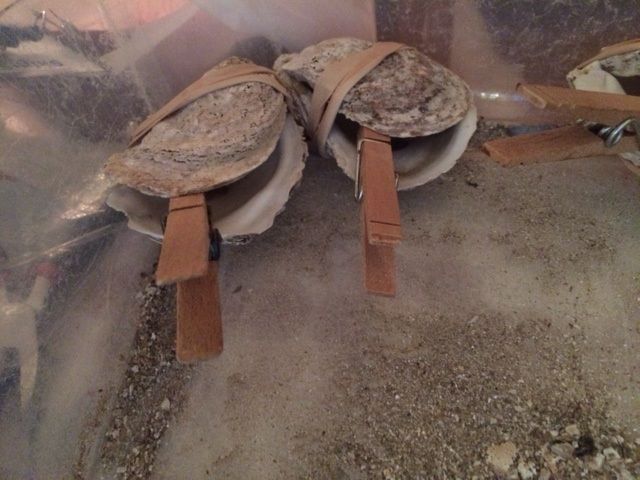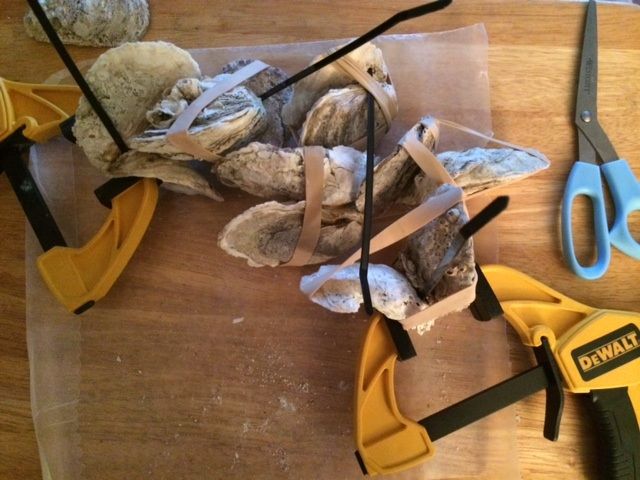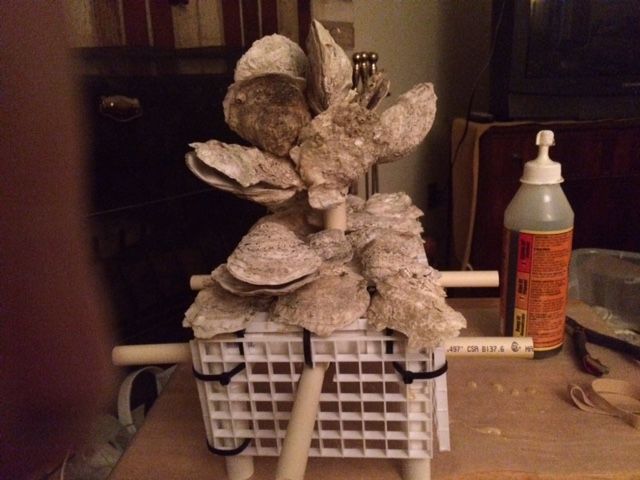But that isn't all. This is only the beginning. What about the little caves and crevices for the fish? The oyster reef as a reef will provide plenty of hiding places for all critters. But, if you want the fish to breed, they have preferences for their amorous activities. They breed in dead or broken oyster shells, as do some of the other species of oyster reefs.
So, back to matching oyster shells again. This time, I matched what I called "near matches" since I wouldn't be gluing them totally together. Basically, i wanted them to look like they'd match if they weren't together, but they didn't have to be exact. So, another night or two of clanking oyster shells to make my family annoyed was in order. The next step was to glue them together and create spawning habitat.
As it turns out, there was a study in 1982 bu Roy E. Crabtree and Douglas P. Middaugh, titled, "Oyster Shell Size and the Selection of Spawning Sites by Chasmodes bosquianus, Hypleurochilus geminatus, Hypsoblennius ionthas (Pisces, Blenniidae) and Gobiosoma bosci (Pisces, Gobiidae) in Two South Carolina Estuaries,", and in that study, they found that the widest preferred oyster shell gap that they found with eggs that the striped blenny preferred for the spawn was 11.9 mm. And, as it turns out, that is the same width as the end of the clothes pins that we had, and they were the perfect form for creating matched spawning oyster caves. Feather blennies also spawn in similar sized oyster shell gaps, so if I catch them, these would be just fine for their exploits.
For the naked gobies, the gap was 7.1 mm, about the measurement of the end of the plastic shims from Home Depot. And the clingfish will spawn in just about anything that they can defend from the others.
Gluing near matched halves together to make fish breeding habitat, using clothes pins as gap forms:

But, would the Gorilla Glue hold? Yes, it did:

So, the past few days I've been drilling holes in oyster shells (man, they are tough), using zip ties, and Gorilla glue to make cultches. I also made frames for the three large sections of oyster reef to support my cultches, and also to be the forms for the MMLR. I used CPVC pipe to make slide on supports for the cultches, zip tied 1/2" CPVC as a pedestal, and the 3/4" CPVC to hold the oyster cultch base to slide over the pedestal. The reef frames were formed from PVC pipe, zip ties and egg crate. When they are finished, 2 sections of reef should be about 18" or so wide, and one smaller one.
Using clamps, zip ties, and rubber bands to form cultches:

One of the reef boxes/bases...these will have glued oyster shells on them, and filled with MMLR (after I finish the cultches):

Building a cultch over the cultch base of CPVC pipe:

Coming along nicely... Starting to look like that first picture, eh? I already took one apart because it didn't look real enough. I hope I don't run out of oysters, but I have all winter, LOL!

And this was as of last night...

The tedious part is waiting for the glue to dry and hold, so you can keep building. I imagine that there are faster ways of doing it, but I'm kind of learning as I go. And, in a way, I'm almost building the reef as if oysters are doing it...and it takes time. Plus, I want it to look perfect, like that second picture above on that mangrove oyster reef.
After I'm done building cultches, they will be set aside and the boxes will be filled with MMLR and kured/cured for use in the tank. A few months of water changes, and I'll be ready to reassemble the cultches in what I hope is a set up cycled tank. So, the problem that I have with live rock along the Bay is that there really isn't any, save for cinder blocks and such, and that's not very attractive. Most of the rock are clay boulders or marl, sandstone, or other metamorphic rocks (quartz, etc).
But, while the MMLR is kuring/curing, I'll be adding other shells to the cultches/reef...slipper shells, a few more barnacles here and there, and of course, some muscle and clam shells, all found locally. I won't have to worry about much time matching them, they're a heck of a lot easier than those variable oysters!